At the heart of Paul Maguire’s farm in Furnace, Co Mayo, lies a remarkable structure: an industrial furnace, built in 1738 to mass produce pig iron for export to England.
It owes its remote location to the presence of natural resources – the iron ore and ‘bog ore’ found nearby, the oak trees to provide charcoal for burning, the (fire-resistant) sandstone for building, the running water to drive sets of bellows to fan the flames, and the river-and-lake network to transport the boatloads of iron.
Paul has been working on the restoration of “the smelter”, as it was locally known, for three decades and, much like the people who built and operated it, he has taken a very creative approach to harnessing his land’s natural assets to make a living. “Green Care” would be one way to describe his approach, which encompasses farming, forestry and using the farm as a ‘place of healing’.
Culture shock
Paul’s mother’s people – the Neachtains – worked the land here for generations, but Paul himself grew up near Dún Laoghaire in Dublin. His father would take him to visit his uncles who “subsisted” on the 72 acres at Furnace. He loved helping out and, no sooner had he finished the Leaving Cert in 1982 than he cycled all the way back west to work full time on the farm.
When his uncle died in 1992, Paul took over the place, initially clearing more land and building stock numbers
In what was an unlikely pairing, the young Dubliner worked closely with his last surviving uncle, cutting turf with a sleán, hand-milking cows, hand-saving loose hay, gaining an understanding and appreciation of the land from a dying breed of people whose tough lives depended on hard work and their innate knowledge of the land. It left a deep impression on him.
When his uncle died in 1992, Paul took over the place, initially clearing more land and building stock numbers.
He soon saw the financial futility of this – it certainly wouldn’t pay the mortgage on the new house he and his wife Fran (also a Dub, who works as a teacher) built after they married a decade later, or see their two daughters through college. There had to be other ways.
Making a living
Paul always loved trees, particularly the 8ac of ancient woodland on the farm, which his uncles valued for outwintering cattle. He was grant-aided in 2007 and 2011 to plant 22ac of mixed woodland, providing a secure income and the prospect of a good pension.

Paul in a 2011 oak plantation which he shapes using handtools.
He later joined the native woodland scheme to help rejuvenate the ancient woodland, with its trophy ash and hazel trees.
On the farming front, he reduced stock – today keeping a handful of Speckled Park heifers – and joined the NPWS Farm Plan scheme. This cut back on workload and costs and brought in additional, reliable annual income for his work in managing the farm’s species-rich grasslands and blanket bogs.
Business was good, but very seasonal and COVID heralded its eventual demise
Paul also tried his hand at tourism, capitalising on the natural beauty of an area dominated by lakes, peatlands and the Partry Mountains. He opened a B&B, even buying a minibus to ferry groups of anglers around. Business was good, but very seasonal and COVID heralded its eventual demise.
Another venture was ‘social farming’ – hosting weekly groups of people with needs, sharing simple farm tasks. Paul found that he had an aptitude for this, and witnessed firsthand its positive impact on users – leading him eventually to a paid job with the Brothers of Charity, where he works today.
Being considerate of the needs of people with disability was always important to Paul. As a trained furniture maker (earning a degree in fine furniture in Letterfrack in 2006), he specialised in designing and making furniture to facilitate independent living for disabled people. Even the Maguire’s B&B was fully wheelchair-accessible.
During his late sister Daphne’s treatment for cancer, Paul became aware of research highlighting the potential of nature-based therapy in boosting white blood cell levels, necessary for chemo treatment.
He now hopes to avail of ‘NeighbourWood Scheme’ funding to improve facilities for patients to visit his farm as part of their healing journey, tapping into a growing green care movement across Europe, where farms are reimagined as ‘regenerative’ places.
Paul is a man of many careers. Farmer, forester, carer, carpenter, B&B host, bus driver – whatever it takes to make a living. He is adamant that he is not a hobby farmer, more a farmer who works the land in a different way, a way that gives him security of income, freedom to avail of other opportunities and the time to simply enjoy his own place.

Paul Maguire at one of the heritage gates he has installed on his farm.
Like many farmers, he is acutely aware of the tough lives his predecessors had on the land, wanting to honour their legacy and that of the land while finding relevant new ways of making a living. In that ongoing quest, he has certainly done his level best.
For more information on social farming, visit socialfarmingireland.ie Austria is a leader in ‘Green Care’ with 124 certified farms, see
greencare.at For information on forestry grants visit teagasc.ie/crops/forestry/grants 
Paul's farm contains a wonderful diversity of trees. \ Deirdre O’Neill
Managing ivy and shaping trees (eg thinning branches on the leeward side) are useful ways to help future-proof trees at a time of increasingly frequent storms.
Name: Paul McGuireFarm type: forestry, beef, wellbeingFarm size: 29haFocus: Acting as a guardian of the farm and using it for the greater good.Schemes: Afforestation, Native Woodland and NPWS Farm Plan Schemes.
At the heart of Paul Maguire’s farm in Furnace, Co Mayo, lies a remarkable structure: an industrial furnace, built in 1738 to mass produce pig iron for export to England.
It owes its remote location to the presence of natural resources – the iron ore and ‘bog ore’ found nearby, the oak trees to provide charcoal for burning, the (fire-resistant) sandstone for building, the running water to drive sets of bellows to fan the flames, and the river-and-lake network to transport the boatloads of iron.
Paul has been working on the restoration of “the smelter”, as it was locally known, for three decades and, much like the people who built and operated it, he has taken a very creative approach to harnessing his land’s natural assets to make a living. “Green Care” would be one way to describe his approach, which encompasses farming, forestry and using the farm as a ‘place of healing’.
Culture shock
Paul’s mother’s people – the Neachtains – worked the land here for generations, but Paul himself grew up near Dún Laoghaire in Dublin. His father would take him to visit his uncles who “subsisted” on the 72 acres at Furnace. He loved helping out and, no sooner had he finished the Leaving Cert in 1982 than he cycled all the way back west to work full time on the farm.
When his uncle died in 1992, Paul took over the place, initially clearing more land and building stock numbers
In what was an unlikely pairing, the young Dubliner worked closely with his last surviving uncle, cutting turf with a sleán, hand-milking cows, hand-saving loose hay, gaining an understanding and appreciation of the land from a dying breed of people whose tough lives depended on hard work and their innate knowledge of the land. It left a deep impression on him.
When his uncle died in 1992, Paul took over the place, initially clearing more land and building stock numbers.
He soon saw the financial futility of this – it certainly wouldn’t pay the mortgage on the new house he and his wife Fran (also a Dub, who works as a teacher) built after they married a decade later, or see their two daughters through college. There had to be other ways.
Making a living
Paul always loved trees, particularly the 8ac of ancient woodland on the farm, which his uncles valued for outwintering cattle. He was grant-aided in 2007 and 2011 to plant 22ac of mixed woodland, providing a secure income and the prospect of a good pension.

Paul in a 2011 oak plantation which he shapes using handtools.
He later joined the native woodland scheme to help rejuvenate the ancient woodland, with its trophy ash and hazel trees.
On the farming front, he reduced stock – today keeping a handful of Speckled Park heifers – and joined the NPWS Farm Plan scheme. This cut back on workload and costs and brought in additional, reliable annual income for his work in managing the farm’s species-rich grasslands and blanket bogs.
Business was good, but very seasonal and COVID heralded its eventual demise
Paul also tried his hand at tourism, capitalising on the natural beauty of an area dominated by lakes, peatlands and the Partry Mountains. He opened a B&B, even buying a minibus to ferry groups of anglers around. Business was good, but very seasonal and COVID heralded its eventual demise.
Another venture was ‘social farming’ – hosting weekly groups of people with needs, sharing simple farm tasks. Paul found that he had an aptitude for this, and witnessed firsthand its positive impact on users – leading him eventually to a paid job with the Brothers of Charity, where he works today.
Being considerate of the needs of people with disability was always important to Paul. As a trained furniture maker (earning a degree in fine furniture in Letterfrack in 2006), he specialised in designing and making furniture to facilitate independent living for disabled people. Even the Maguire’s B&B was fully wheelchair-accessible.
During his late sister Daphne’s treatment for cancer, Paul became aware of research highlighting the potential of nature-based therapy in boosting white blood cell levels, necessary for chemo treatment.
He now hopes to avail of ‘NeighbourWood Scheme’ funding to improve facilities for patients to visit his farm as part of their healing journey, tapping into a growing green care movement across Europe, where farms are reimagined as ‘regenerative’ places.
Paul is a man of many careers. Farmer, forester, carer, carpenter, B&B host, bus driver – whatever it takes to make a living. He is adamant that he is not a hobby farmer, more a farmer who works the land in a different way, a way that gives him security of income, freedom to avail of other opportunities and the time to simply enjoy his own place.

Paul Maguire at one of the heritage gates he has installed on his farm.
Like many farmers, he is acutely aware of the tough lives his predecessors had on the land, wanting to honour their legacy and that of the land while finding relevant new ways of making a living. In that ongoing quest, he has certainly done his level best.
For more information on social farming, visit socialfarmingireland.ie Austria is a leader in ‘Green Care’ with 124 certified farms, see
greencare.at For information on forestry grants visit teagasc.ie/crops/forestry/grants 
Paul's farm contains a wonderful diversity of trees. \ Deirdre O’Neill
Managing ivy and shaping trees (eg thinning branches on the leeward side) are useful ways to help future-proof trees at a time of increasingly frequent storms.
Name: Paul McGuireFarm type: forestry, beef, wellbeingFarm size: 29haFocus: Acting as a guardian of the farm and using it for the greater good.Schemes: Afforestation, Native Woodland and NPWS Farm Plan Schemes. 












SHARING OPTIONS